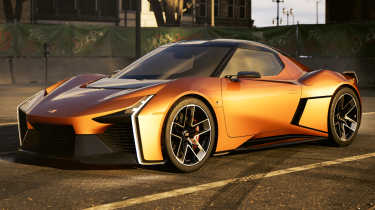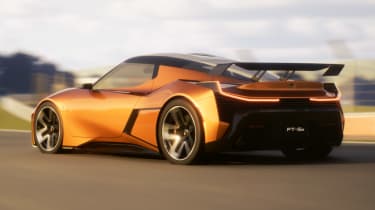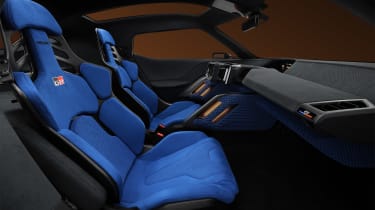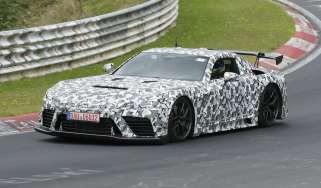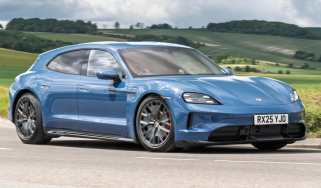Toyota's FT-Se sports car could make production
Pure-electric GR-badged two-seater is a concept for now – but a production version hasn’t been ruled out
Toyota has shown off its vision of an all-electric GR sports car once again at its Kenshiki forum event in Brussels, and evo has been up close with the car and its creators to learn more about it.
First revealed at the 2023 Japan Mobility Show in October, the two-seater concept is called the Toyota FT-Se (for Future Toyota Sports electric). It’s an evolution of the Sports EV concept first shown in 2021 when Toyota previewed a roadmap of future electric models.
> Toyota’s future EV plans laid out – new electric sports car in the works
It wears GR badges, rather than Toyota ones, however: ‘This is to give this car a distinct profile, it’s quite a statement,’ says Toyota’s Patrick Scheeler, who is the product manager for the existing GR Supra, GR86 and GR Yaris.
The car’s distinct profile was designed largely by Hideaki Iida, GR Design Group project manager. ‘The biggest difference in design language between GR and a Lexus or Toyota design, for example, is that I started with aero, rather than sketching,’ he told evo. ‘Normally with design you start with sketches, doodles; with this car I started with aerodynamic information. Some of the feedback we’ve had [since its reveal] is that it’s a really realistic show car – I think that approach is why.’
By modern standards the FT-Se is a compact, low car in person, with a wheelbase of 2.6m (a little longer than a Toyota GR86, and similar overall dimensions to a GR Supra). It’s a concept model with a full interior as opposed to a working car, but it’s been nominally designed around Toyota and Lexus’s upcoming all-new ‘gigacast’ EV architecture, which builds the car in three modular sections: the battery pack is sited in the car’s middle section and large one-piece assemblies are added front and rear.
‘Every part of the company will benefit from the new platform – and that includes GR,’ Toyota Europe COO Matt Harrison told media at the Kenshiki event. That platform has been designed to incorporate new prismatic batteries, with greater range and quicker charging capability than Toyota’s current-generation batteries, and a new ‘Arene’ operating system with over-the-air updates (which could include downloadable ‘engine sounds’ and adaptable drive modes) and various advanced concierge services.
While there is no engine, naturally, the FT-Se’s proportions are similar to a traditional mid-engined sports car. ‘That comes from where the battery is,’ Iida-san says. ‘I had some freedom with the dimensions and the surfaces. The ‘hammerhead’ front design is one of the strongest design cues of Toyota; in this case, I used it in a functional way.’ Air is ducted through the nose’s lower section and out through the upper vents for cooling and aerodynamic purposes, and those sections are picked out in black to play with the car’s perceived proportions. ‘The idea to put the black into the bonnet came from there being no engine in this car – I wanted to make a virtue of that,’ Iida-san says, ‘and it also accentuates the car’s dimensions.’
There are active aerodynamics in the form of a pop-up rear spoiler (while the rear lights have a dual purpose as aero fins), and pop-out cooling vents on FT-Se’s flanks, which can lie flush with the surface or shift outwards to cool the battery and brakes. ‘That was one of my dreams to realise; nobody did it before,’ Iida-san tells evo. He cautions, however, that a lot of testing would be required to realise the system for the road and ensure that it works effectively.
Gazoo Racing’s Patrick Scheeler says that no decisions have been made as to how many motors a functional version would have. ‘We are still pondering what is best, in terms of how many motors.’ He adds that the simulated manual gearbox Toyota has developed for battery-electric vehicles in prototype form (and which Lexus general manager for electric cars Shinya Ito says is being ‘seriously considered’ for production) could find a home in a car like this. The FT-Se concept has paddles behind the steering wheel but ‘paddles or a stick – or if it will have “gears” – is not decided,’ Scheeler explains.
Scheeler adds that incorporating sound – and potentially, simulated gearshifts – into electric cars is something GR and wider Toyota is putting a great deal of thought into. It’s not only about ‘how to communicate excitement,’ he explains; ‘[by] losing the sound, one of your senses is taken away in terms of knowing where you are. You can only look, normally, in an electric car, you don’t get auditory feedback.’
Steering is intended to be a steer-by-wire system. The FT-Se’s cabin features unique cell-like mesh structures to protect occupants from G-forces, something that might offer some indication as to the level of performance its creators have in mind. Carbonfibre Recaro bucket seats also make its focus clear, as does plenty of Alcantara and matt-finish carbonfibre trim throughout. The HMI system is the same as that shown in recent Lexus concept cars, such as the LF-ZC.
Senior figures at Toyota have so far been careful to emphasise that the FT-Se is purely a concept car, and a commitment hasn’t been made to produce a road-going version – but a pure-electric GR road-going performance car will come in the near future. It hasn’t yet been ruled out that it might take a similar form to the FT-Se.
Scheeler says that given the car’s dimensions and performance focus, economies of scale would be needed to make a production version affordable, and that there are considerable challenges around keeping the mass down and managing weight transfer for dynamics, but adds: ‘There are no roses around this story; if it is not possible, we won’t show it. This is a strong representation of how we see multi-point technology [i.e. a range of power sources for customers]. And we will try to make it affordable.’
He adds: ‘Weight distribution, cost reduction are all challenges. We have to think smartly in a BEV era, because of the challenges every OEM is facing [as well].’
While Iida-san freely acknowledges that mainstream sports cars are not generally a commercially strong prospect in the current global market, the FT-Se is mobbed during the Kenshiki forum event, with constant crowds around the car. Feedback from its debut at the 2023 Japan Mobility Show was very favourable: ‘I’m really happy about the feedback,’ he says. ‘And that gives the project a stronger acceleration in the internal company.’ He adds that he’s hopeful a positive reaction and voice from the public might accelerate the progress of a production version.
‘[This car] is also about getting the first feedback from people seeing it,’ Scheeler says. ‘One hundred per cent, we want to develop an exciting BEV product.’
